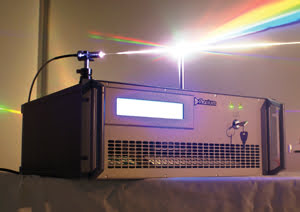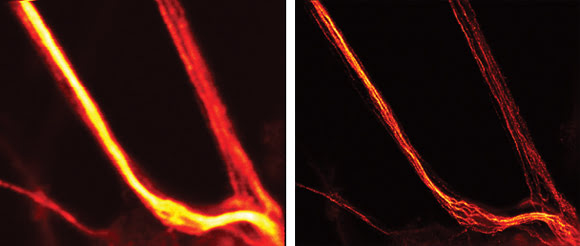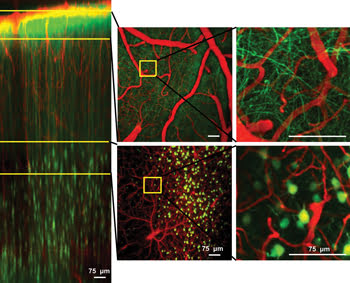Ultrafast fiber lasers, found in countless research laboratories around the globe, are popular
tools for physicists and biologists. Favored for being compact and reliable, fiber
lasers also come at a fraction of the cost of comparable solid-state sources, which
means that they take up a smaller portion of research grants.
What’s more, maintenance-free operation of these lasers
leaves scientists with more time to focus on their core research rather than on
having to be part-time laser physicists, constantly tweaking and adjusting, as is
required by the solid-state counterparts.
In fact, there are many positives when it comes to fiber lasers:
They are robust, efficient and easy to power scale, and they have lower cooling
requirements. Surely, then, the biomedical industry can’t be far behind in
accepting this small but mighty laser into its collection?
Many laser manufacturers and researchers seem to think so. We
are already seeing some ophthalmic surgeons adopting fiber lasers for lasik surgery.
The vision correction procedure uses a femtosecond laser to cut a flap in the cornea
prior to ultraviolet laser ablation to adjust the refractive power of the eye.
Femtosecond fiber lasers are fast becoming the technology of choice
for this procedure because they offer a route to bringing down the capital equipment
cost and hence reduce the cost per procedure. Furthermore, the compact size of the
fiber-based system enables footprint reduction of the surgical tool, which will
become increasingly important as ophthalmic surgery further penetrates global markets.
Fiber laser adoption could extend into other areas, such as multiphoton
microscopy, surgical procedures, and imaging techniques that offer higher speed
and resolution, as well as lower-cost instrumentation, making them more available
to clinics and research facilities.
In Southampton, UK, Fianium is working on an all-fiber approach
to creating discrete-wavelength laser sources at any wavelength within the visible
and ultraviolet ranges. Sources within this range typically are used for biomedical
imaging. To create such sources, nonlinear frequency conversion must be exploited.
“We are able to achieve these with 100-mW power levels which will challenge
conventional diode laser technology,” said John Clowes, director of business
development at Fianium.

Turnkey supercontinuum or white-light
lasers from Fianium have been enabled by highly reliable ultrafast fiber laser technology.
These state-of-the-art lasers provide every wavelength in the visible and near-infrared
region of the spectrum, from below 400 nm to beyond 2 μm. Courtesy of Fianium.
Fianium is a fiber laser company that manufactures ultrafast,
high-power laser systems spanning the 240- to 2500-nm region. But one of its specialties
is its supercontinuum fiber laser sources, which have applications in fluorescence
microscopy, imaging and spectroscopy. A supercontinuum laser is an ultrabroadband
source of light that maintains the spatial beam properties of a laser.
“In the past, laser-based imaging and spectroscopy applications
have had to make do with the limited available discrete wavelengths offered by diode
and argon-ion lasers to excite fluorescent molecules,” Clowes said. “The
supercontinuum offers every wavelength from the blue to short-wavelength infrared.
For fluorescence excitation, all that is needed is a supercontinuum and a set of
filters to choose the optimum wavelength; it is therefore an ideal source for imaging.”
Fianium has seen rapid growth in supercontinuum installations
over the past six years, with scientific researchers forming the majority of early
adopters of the technology; however, Clowes points out that with increasing maturity
of the technology, including higher powers, and brighter and whiter supercontinuum
sources, as well as significant cost reduction in volumes, we are beginning to see
many industrial applications develop.
“In terms of the fiber supercontinuum systems, we have scaled
the power to beyond 10 watts and are delivering systems with more than 1.5 watts
of power in the visible region of the spectrum – a fivefold increase in the
six years since we developed the technology,” Clowes said. “In the laboratory,
we have pushed this level to several watts and more than 15 milliwatts of power
for every nanometer of the visible spectrum. We are now focused on the challenges
of transferring this into commercial products with the reliability demanded by our
customers.”
Obstacles to overcome
Fiber lasers are not without drawbacks, however, particularly
when it comes to generating higher energy and shorter pulses. Because of the small
confinement area of light in the fiber, high-intensity pulses can produce several
nonlinear and thermal effects that can affect performance.
A group at Cornell University in Ithaca, N.Y., working under professor
Frank Wise, is hoping to develop methods that will produce high-intensity pulses
despite these nonlinearities.
“A short pulse of even modest energy can experience significant
nonlinear effects on propagation through a long length of fiber with a small core,”
Wise said. “These distort, or even destroy, a pulse.”
One of the most significant developments in the technology –
and one that has helped the community realize the potential of fiber lasers –
is the fabrication of fibers with larger cores. This serves to reduce nonlinear
effects and has led to high-power fiber lasers.
In the past couple of years, the Wise group has reported new ways
of developing femtosecond-pulse fiber lasers that exhibit much higher energies than
in the past. These methods appear in papers published in Optics Letters in 2009
and 2010.
The performance (power and pulse duration) of these lasers now
reaches, and even exceeds, the performance of femtosecond Ti:sapphire lasers that
set the standard in the field. Since the pulses generated by the fiber lasers can
tolerate large nonlinear effects, they can be stable at higher energies. A drawback,
however, is that fiber lasers are not broadly wavelength-tunable.
Wise and colleagues recently reported the incorporation of a new
high-power femtosecond fiber laser into a multiphoton microscope built in professor
Chris Schaffer’s laboratory, also at Cornell. Together, they performed a craniotomy
on an anesthetized mouse to obtain optical access to the brain. “Schaffer
used a transgenic mouse that expresses yellow fluorescent protein in a subset of
pyramidal neurons in the mouse cortex,” Wise said. “To visualize vasculature
[the circulatory system], he intravenously injected Texas Red dextran.”
 Two images of neurons
were taken using a Fianium supercontinuum fiber laser within a confocal and stimulated
emission depletion (STED) microscope. STED is a superresolution imaging technique
developed to overcome the diffraction limit. The images clearly show the improved
resolution of STED, right, over conventional confocal microscopy, left. Images courtesy
of the Department of NanoBiophotonics, Max Planck Institute for Biophysical Chemistry,
Göttingen, Germany.
Two images of neurons
were taken using a Fianium supercontinuum fiber laser within a confocal and stimulated
emission depletion (STED) microscope. STED is a superresolution imaging technique
developed to overcome the diffraction limit. The images clearly show the improved
resolution of STED, right, over conventional confocal microscopy, left. Images courtesy
of the Department of NanoBiophotonics, Max Planck Institute for Biophysical Chemistry,
Göttingen, Germany.
And the result: two-photon-excited fluorescence images of unparalleled
quality obtained at depths of up to 900 μm – almost the full thickness
of the mouse cortex.
It is the long wavelength (1060 nm) of the fiber laser that aids
transmission of light through the tissue of the mouse and that Wise believes is
a good indication that a simple and cheap fiber laser will one day be able to replace
Ti:sapphire in multiphoton microscopy.
While two-photon-excited fluorescence microscopy requires the
structure of interest to be labeled, other imaging techniques can operate without
that restriction. Coherent anti-stokes Raman scattering (CARS) imaging is one such
method, and fiber lasers could offer advantages here, too.
 CARS imaging does not require the injection of fluorescent labels;
instead, the image is generated from the cell tissue itself. Wise has worked in
collaboration with professor Sunney Xie’s group at Harvard University in Cambridge,
Mass., to build a fiber laser for CARS imaging. When applied with endoscopic versions
of CARS that are being developed today, the laser could bring the powerful imaging
technique into the mainstream. “People are working to make CARS a real-time
tool for pathology (of brain tissue, for example); for the technique to reach real
clinical applications, the compact, (eventually) inexpensive fiber lasers will
have advantages,” Wise said.
CARS imaging does not require the injection of fluorescent labels;
instead, the image is generated from the cell tissue itself. Wise has worked in
collaboration with professor Sunney Xie’s group at Harvard University in Cambridge,
Mass., to build a fiber laser for CARS imaging. When applied with endoscopic versions
of CARS that are being developed today, the laser could bring the powerful imaging
technique into the mainstream. “People are working to make CARS a real-time
tool for pathology (of brain tissue, for example); for the technique to reach real
clinical applications, the compact, (eventually) inexpensive fiber lasers will
have advantages,” Wise said.
It is no surprise that fiber lasers, with their ability to operate
at not only high but also low energies, are lending themselves well to biomedical
applications. Procedures on sensitive tissue such as the eye or skin require low
pulse energies, typically less than 20 μJ, and ultrafast fiber technology sits
comfortably in this region.
As laser scientists continue to close the gap between fiber and
solid-state sources, we should see more imaging technologies and medical procedures
become cheaper and more accessible, thanks to fiber lasers.